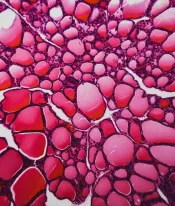Ancient sea creatures offer fresh insights into cancer

Sponges are an evolutionary riddle. A new study shows they are capable of withstanding levels of radiation that would prove lethal to most other organisms. Researchers hope to better understand their impressive radioresistance and ability to suppress cancer, which may hold vital clues for cancer suppression and prevention in humans and other animals. Graphic by Jason Drees
Sponges are among the oldest animals on Earth, dating back at least 600 million years. Comprising thousands of species, some with lifespans of up to 10,000 years, they are a biological enigma.
Researchers at Arizona State University have shed new light on a species of sponge called Tethya wilhelma and the creature’s remarkable capacity to withstand radiation and resist cancer.
Scientists are intrigued by the fact that there are no recorded cases of cancer in sponges, despite their long lifespans and continuous cell renewal. The new study provides the first experimental evidence that T. wilhelma sponges survive, experience minimal damage to their DNA and do not appear to develop cancer following exposure to heavy doses of radiation, suggesting an extraordinary ability to repair or prevent radiation-induced damage to their DNA.
This remarkable resilience, reported in the current issue of the journal Biology, offers insights into evolutionary tactics of cancer prevention and suppression that may one day help treat or prevent cancers in humans and other animals. The research may also inspire new techniques to protect humans in high-radiation environments, including nuclear reactors and during space travel.
“The level of X-ray radiation we used should absolutely obliterate the DNA in these sponges, but they seem to just shrug it off. It’s the closest thing to a superpower that I’ve ever seen,” says Carlo Maley, who led the study.
Maley is a researcher in the Biodesign Center for Biocomputing, Security and Society, professor in the School of Life Sciences at ASU and director of the Arizona Cancer Evolution Center.
He is joined by ASU colleagues, including corresponding author Angelo Fortunato, Jake Taylor, Jonathan Scirone, Sareh Seyedi and Athena Aktipis.
Cancer: A common thread
Cancer, a disease that subverts the mechanisms of evolution to cause disease, continues to exact a devastating toll. For humans, it remains the second-leading cause of death. While great strides have been made in understanding and successfully treating some cancers, others, including myeloid leukemia, pancreatic cancer and glioblastoma, still have a grim prognosis.
Humans are not alone. All multicellular organisms share a fundamental vulnerability to cancer. Unlike single-celled life, which reproduces independently, multicellular creatures rely on cooperative cell division and specialization. This cooperation creates an Achilles’ heel: When cells mutate and escape the body's regulatory mechanisms, they can proliferate uncontrollably, forming tumors.
Generally, the longer an organism lives and the more its cells divide, the greater the chance of these mutations accumulating. While some species have evolved mechanisms to suppress cancer, no multicellular life form is entirely immune, making cancer a nearly inevitable consequence of complex life.
Maley and his colleagues, having previously explored cancer suppression and cancer prevalence in elephants, whales, birds and across the tree of life, now turn their attention to sponges. Despite their extraordinary lifespans, sponges appear to have exceptionally low cancer rates — or perhaps none at all.
The latest in cancer research
The Biodesign Institute is taking a comprehensive approach to cancer research — from diagnosis and treatment to prevention — as well as a collaborative approach that unites clinicians and researchers of different expertise. Click here to learn more.
Radioresistance
In the new study, T. wilhelma sponges proved they could withstand extreme levels of radiation — up to 100 times the lethal dose for humans — without developing cancer. Following exposure, only 8% of the cells showed DNA shattering, suggesting that not only were the sponges capable of sophisticated DNA repair, but they were also able to protect their DNA from damage in the first place.
The researchers used a powerful X-ray machine to expose the sponges to 518 Gray (Gy) of radiation — a dose that would kill a human instantly. Instead of dying, the sponges temporarily shrank and underwent structural changes, but over time, they recovered and resumed normal growth.
Using advanced genetic analysis, the scientists discovered that the sponges activated a unique set of genes linked to DNA repair and stress response. These included genes similar to those found in humans that help repair damaged DNA, but the sponges appeared to use them more effectively and over a longer time. Some of the genes identified are also linked to embryonic development, suggesting that the sponges may be able to reset their cells to a more resilient state after damage.
The discoveries could lead to the identification of new DNA protection and repair mechanisms, as well as sponge-derived molecules that may serve as the basis for developing drugs to protect against radiation and cancer.
Shape-shifting biology
Sponges exist in both marine and freshwater habitats and are found from shallow reefs to the deep sea, including under Antarctic ice shelves and hydrothermal vents. They are prime examples of resilience in nature, with some species able to endure extreme environmental conditions. Some deep-sea glass sponges, for example, can withstand immense pressure and low temperatures.
Unlike most animals, sponges lack a nervous system, muscles or digestive organs. Yet they efficiently filter massive amounts of water for food and oxygen using specialized cells called choanocytes. Some species can filter up to 50,000 times their body volume in water per day.
Many sponges have the remarkable ability to reassemble after being physically separated, a phenomenon known as cellular reaggregation. For example, if a sponge is passed through a fine sieve, breaking it into individual cells, these cells can slowly reorganize, recognize each other and reassemble into a complete, living sponge — much like the liquid metal assassin in the film "Terminator 2."
Sponges can also produce potent bioactive compounds, many of which researchers are exploring for use in antibiotics, anti-cancer drugs and even HIV treatments.
By uncovering the remarkable resilience of sponges to radiation and their potential ability to suppress cancer, this study provides new avenues for medical and evolutionary research. Understanding the mechanisms behind sponge DNA protection and repair could one day lead to breakthroughs in cancer prevention and treatments that protect human cells from radiation damage.
More Science and technology

Turning up the light: Plants, semiconductors and fuel production
What can plants and semiconductors teach us about fuel production?ASU's Gary Moore hopes to find out.With the aim of learning how to create viable alternatives to fossil-based fuels, Moore — an…

ASU technical innovation enables more reliable and less expensive electricity
Growing demand for electricity is pushing the energy sector to innovate faster and deploy more resources to keep the lights on and costs low. Clean energy is being pursued with greater fervor,…

What do a spacecraft, a skeleton and an asteroid have in common? This ASU professor
NASA’s Lucy spacecraft will probe an asteroid as it flys by it on Sunday — one with a connection to the mission name.The asteroid is named Donaldjohanson, after Donald Johanson, who founded Arizona…



